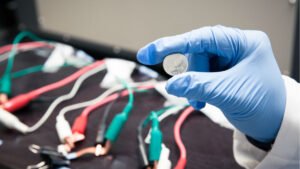Introduction
The integration of biodegradable polymers in the electrical industry marks a significant leap towards sustainability and environmental stewardship. As the demand for eco-friendly materials rises, understanding how to create and use biodegradable polymers becomes essential for manufacturers and engineers.
The electrical industry has historically relied on traditional polymers for insulation, components, and various other applications. However, the environmental impact of these non-biodegradable materials has prompted a shift towards more sustainable alternatives. Biodegradable polymers offer a promising solution, combining the necessary properties for electrical applications with the ability to decompose naturally, thereby reducing pollution and waste. This post will delve into the methods of creating biodegradable polymers, their uses in the electrical industry, benefits and future prospects and the potential challenges and innovations on the horizon.

1. Understanding Biodegradable Polymers
What Are Biodegradable Polymers?
Biodegradable polymers are materials that can be broken down by microorganisms into water, carbon dioxide (CO2), and biomass. Unlike traditional plastics, which can persist in the environment for hundreds of years, biodegradable polymers decompose relatively quickly under the right conditions, minimizing their environmental footprint. These polymers can be derived from natural sources such as starch, cellulose, and polylactic acid (PLA), or synthesized from petrochemical compounds with additives that promote biodegradation.
Properties Required for Electrical Applications
For biodegradable polymers to be viable in the electrical industry, they must possess specific properties, including:
- Electrical Insulation: Effective insulation properties to prevent electrical leakage and ensure safety.
- Thermal Stability: Ability to withstand the operating temperatures of electrical devices without degrading.
- Mechanical Strength: Sufficient strength to endure physical stress and mechanical wear.
- Chemical Resistance: Resistance to chemicals and moisture to maintain integrity over time.
2. Creating Biodegradable Polymers for the Electrical Industry
Material Selection and Sourcing
Creating biodegradable polymers starts with selecting suitable raw materials. Commonly used materials include:
- Polylactic Acid (PLA): Derived from renewable resources like corn starch or sugarcane, PLA is a popular choice for biodegradable applications due to its good mechanical properties and biodegradability.
- Polyhydroxyalkanoates (PHA): Produced by bacterial fermentation of sugars and lipids, PHAs offer excellent biodegradability and can be tailored for various applications.
- Starch-Based Polymers: These polymers are made by blending starch with other biodegradable materials to enhance their properties for specific uses.
Polymer Synthesis and Processing
The synthesis of biodegradable polymers involves polymerization processes that link monomers into long polymer chains. For example, PLA is produced through the polymerization of lactic acid monomers. Key steps in the processing of biodegradable polymers include:
- Extrusion: Melting and shaping the polymer into desired forms, such as films, sheets, or fibers.
- Injection Molding: Injecting the molten polymer into molds to create complex shapes and components.
- Blow Molding: Forming hollow parts like insulation tubes or casings.
Additives and Blends
To meet the specific requirements of the electrical industry, biodegradable polymers can be blended with additives that enhance their properties. Common additives include:
- Plasticizers: Improve flexibility and reduce brittleness.
- Stabilizers: Enhance thermal and UV stability.
- Reinforcing Agents: Increase mechanical strength and durability.
3. Applications of Biodegradable Polymers in the Electrical Industry
Insulation Materials
One of the primary applications of biodegradable polymers in the electrical industry is insulation. Traditional polymers like PVC and polyethylene are widely used for insulating wires and cables, but biodegradable alternatives are gaining traction. PLA and PHA, with appropriate additives, can provide the necessary insulation properties while being environmentally friendly.
Components and Casings
Biodegradable polymers can also be used to manufacture various components and casings for electrical devices. These include:
- Connectors and Switches: Biodegradable polymers can be molded into connectors and switches, providing both functionality and sustainability.
- Device Housings: PLA and other biodegradable materials can be used for the outer casings of devices like remote controls, chargers, and other small electronics.
Printed Circuit Boards (PCBs)
Researchers are exploring the use of biodegradable polymers in the production of PCBs. Traditional PCBs are made from non-degradable materials that contribute to electronic waste. By using biodegradable substrates, the environmental impact of discarded electronics can be significantly reduced.
4. Challenges and Innovations
Challenges
While the potential benefits of biodegradable polymers in the electrical industry are significant, there are challenges to overcome:
- Performance Limitations: Ensuring that biodegradable polymers meet the high-performance standards required for electrical applications can be challenging. Research and development are needed to enhance their properties.
- Cost: Biodegradable polymers can be more expensive to produce than traditional plastics. Scaling up production and improving manufacturing processes can help reduce costs.
- Durability: Ensuring that biodegradable polymers maintain their properties over the lifespan of electrical devices is crucial. Innovations in material science are needed to enhance their durability.
Innovations
Despite these challenges, there are numerous innovations driving the adoption of biodegradable polymers in the electrical industry:
- Advanced Blends: Researchers are developing advanced polymer blends that combine biodegradable materials with other compounds to enhance their properties.
- Nanotechnology: Incorporating nanomaterials into biodegradable polymers can improve their electrical and mechanical properties, making them more suitable for high-performance applications.
- Recycling and Composting Technologies: Developing efficient recycling and composting technologies for biodegradable polymers can further reduce their environmental impact.
Conclusion
The adoption of biodegradable polymers in the electrical industry represents a significant step towards sustainability and environmental responsibility. By understanding how to create and use these materials, manufacturers and engineers can contribute to reducing electronic waste and pollution. While challenges remain, ongoing research and innovation promise to enhance the performance and affordability of biodegradable polymers, paving the way for their widespread use in electrical applications.
If you found this article informative or have any questions, we invite you to leave a comment below. Your feedback and insights are valuable to us as we continue to explore the potential of biodegradable polymers in various industries.





